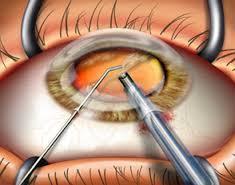If you are one of the millions of people who suffer from cataracts, you may be wondering about the different types of surgery available to you. In this blog post, we will discuss the three most common procedures. We will also explore some of the benefits and drawbacks of each procedure. By understanding the different options available to you, you can make an informed decision about which type of surgery is best for you.
Defining Cataract Surgery
 Cataract surgery is a medical procedure to remove the cloudy lens of your eye and replace it with a clear artificial lens. It is one of the most common surgeries performed in the United States, and more than 98% of people who have cataract surgery experience improved vision afterward.
Cataract surgery is a medical procedure to remove the cloudy lens of your eye and replace it with a clear artificial lens. It is one of the most common surgeries performed in the United States, and more than 98% of people who have cataract surgery experience improved vision afterward.
While there are many types of cataract surgery, all of them share the same goal: to improve your vision.
It is important to note that cataract surgery is not a cure for other eye conditions, such as glaucoma or macular degeneration. However, it can improve your vision and quality of life. It can also be a matter of safety, as cataracts can make it difficult to drive or see in low light.
Over the years, thanks to the advancements in medical technology, cataract surgery has become increasingly safe and effective. In fact, it is now one of the most successful surgeries performed today.
Types Of Cataract Surgery
Now that we have a general understanding of what cataract surgery is, let’s take a closer look at its types. We will examine the most common procedures, as well as some of the benefits and drawbacks of each.
Traditional Cataract Surgery
Starting with the most obvious and common type of surgery, traditional cataract surgery is performed by making a small incision in the eye. Through this incision, your surgeon will insert a tiny instrument called an intraocular lens, or IOL. The IOL will then be positioned in front of your natural lens.
One of the primary benefits of traditional cataract surgery is that it is very effective. In most cases, patients experience significantly improved vision after surgery. Another benefit is that traditional cataract surgery has a relatively short recovery time. Most people are able to return to their normal activities within a few days.
There are some drawbacks to traditional cataract surgery, however. One is that it requires the use of general anesthesia, which can be risky for some people. Additionally, because traditional cataract surgery involves making an incision in the eye, there is a small risk of infection.
Phacoemulsification
 Phacoemulsification, also known as “keyhole” or “mini” surgery, is a type of cataract surgery that uses ultrasonic waves to break up the cloudy lens of your eye. Once the lens has been broken up, it can be suctioned out through a small incision.
Phacoemulsification, also known as “keyhole” or “mini” surgery, is a type of cataract surgery that uses ultrasonic waves to break up the cloudy lens of your eye. Once the lens has been broken up, it can be suctioned out through a small incision.
Phacoemulsification has several benefits over traditional cataract surgery. First, because it doesn’t require a large incision, there is a lower risk of infection. Additionally, phacoemulsification is usually performed under local anesthesia, which is safer than general anesthesia. Finally, recovery from phacoemulsification is typically quicker than recovery from traditional cataract surgery.
While phacoemulsification has many advantages, it also has some drawbacks. One is that it is a more complex procedure than traditional cataract surgery, which means it may take longer to perform. Additionally, phacoemulsification can be more expensive than traditional surgery.
Extracapsular surgery
Extracapsular surgery is a type of cataract surgery that involves making a large incision in the eye. Through this incision, your surgeon will remove the cloudy lens of your eye and replace it with an IOL. This procedure differs from traditional cataract surgery in that the IOL is placed behind the natural lens, rather than in front of it.
There are several benefits to extracapsular surgery. One is that it provides a larger opening for your surgeon to work through, which can be helpful if your cataracts are particularly severe. Additionally, it is very effective. In most cases, patients experience significantly improved vision after surgery. Additionally, extracapsular surgery has a relatively short recovery time. Most people are able to return to their normal activities within a few days.
There are some drawbacks to extracapsular surgery, however. One is that it requires the use of general anesthesia, which can be risky for some people. Additionally, because extracapsular surgery
Intracapsular surgery
Lastly, the least common type of cataract surgery is intracapsular surgery. This procedure is very similar to extracapsular surgery, except that the incision made in the eye is much smaller. Additionally, rather than removing the entire lens of your eye, only the central portion of the lens is removed. The IOL is then placed in front of your natural lens.
There are several benefits to intracapsular surgery. One is that it is less invasive than other types of cataract surgery, which means there is a lower risk of complications. Additionally, because the incision made in the eye is smaller, there is a lower risk of infection. Finally, intracapsular surgery has a shorter recovery time than other types of cataract surgery.
There are some drawbacks to intracapsular surgery, however. One is that it is a more complex procedure than traditional cataract surgery, which means it may take longer to perform. Additionally, intracapsular surgery can be more expensive than traditional surgery.
These are all types of cataract surgery. While each has its own set of benefits and drawbacks, all are effective at improving vision and quality of life. Talk to your doctor to see which type of surgery is right for you. It is important to assess and understand the risks and benefits of each type before making a decision.
Choosing The Right Type Of Cataract Surgery
 Which type of surgery is best for you will depend on a number of factors, including:
Which type of surgery is best for you will depend on a number of factors, including:
- The severity of your cataracts: This means that people with more severe cataracts may require a more invasive type of surgery, such as extracapsular surgery.
- Your age and overall health: This is because older and/or sicker people may be at a higher risk for complications from surgery.
- Your lifestyle: This is because people who have more active lifestyles may require a type of surgery that has a shorter recovery time.
- Your financial situation: This is because some types of surgery, such as intracapsular surgery, can be more expensive than others.
- Your personal preferences: Lastly, it is important to consider your own personal preferences. Some people may prefer a less invasive type of surgery, even if it takes longer to recover from.
After a thorough evaluation, your doctor will be able to recommend the best type of surgery for you. They will also be able to answer any questions you may have about the risks and benefits of each type of surgery.
Conclusion
In conclusion of the above, cataract surgery is a common procedure that is typically very successful. There are different types of cataract surgery, each with its own set of benefits and drawbacks. It is important to talk to your doctor to see which type of surgery is right for you. Understanding the risks and benefits of each type of surgery is essential to making an informed decision.
If you have cataracts, don’t wait to get them fixed! Cataract surgery is a common, safe, and effective procedure that can improve your vision and quality of life. At EyeMantra we have a team of experienced eye surgeons, who will be happy to answer your any questions on cataract surgery, cataract surgery cost, cataract lens cost for different cataract surgery types- Phacoemulsification, MICS & Femto Laser Cataract . Call us at +91-9711116605 or email at [email protected] for inquiries.


